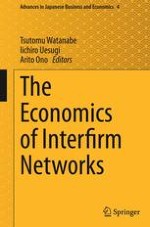2015 | OriginalPaper | Buchkapitel
12. Bank Lending and Firm Activities: Overcoming Identification Problems
verfasst von : Kaoru Hosono, Daisuke Miyakawa
Erschienen in: The Economics of Interfirm Networks
Verlag: Springer Japan
Aktivieren Sie unsere intelligente Suche, um passende Fachinhalte oder Patente zu finden.
Wählen Sie Textabschnitte aus um mit Künstlicher Intelligenz passenden Patente zu finden. powered by
Markieren Sie Textabschnitte, um KI-gestützt weitere passende Inhalte zu finden. powered by
